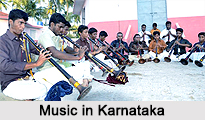 Music in Karnataka has different variations. The main forms of music of Karnataka are Indian and Carnatic Music. In the era of monarchy, the artistes received royal patronage and every possible step was taken to encourage and popularize music. Until date, Karnataka remains an important centre for learning Indian classical music.
Music in Karnataka has different variations. The main forms of music of Karnataka are Indian and Carnatic Music. In the era of monarchy, the artistes received royal patronage and every possible step was taken to encourage and popularize music. Until date, Karnataka remains an important centre for learning Indian classical music.
The most well known leaders of Bhakti Movement belonged to Karnataka. With the rise of Vaishnavism and Haridasa (14th century) movements illustrious composers like Purandara Dasa, Vijaya Dasa, Kanakdasa and others came into being. Their songs had simple lyrics and melodious tunes. These were devotional in nature.
The traditional Guru-Shishya system dates back to ancient India. The teacher would impart musical lessons to its students through "abhyasa" or "riyaaz". Songs or music was never penned down. It was taught orally. It was said that music is an art, which needs aradhana, i.e. complete dedication and practice. Only regular practice could make a singer perfect. According to historical sources, classical music began as abhyasa and at a later stage, it developed as shastras. In the 300 B.C. (age of Bharatmuni) the theories concerning music were for the first time written down. The first document was called `Naatya Shaastra."
According to legends, Gopala Nayaka went to the court of Ala-ud-din Khilji, in the north. He befriended the Persian musician, Amir Khusrau. Their discussion led to the development of new Ragas. The amalgamation of cultures led to the development of two ways of singing -Uttaradi and Dakshinadi or Hindustani Music (Hindustani Classical Music in Modern India) and Carnatic Music. The rich heritage of music also owes its development to the Vijayanagar Empire and Woodeyar kingdoms. Young talents were always encouraged by these dynasties.
The Carnatic music has a deep understanding of notes and their relations. Gamaka establishes this relation. To master this art it has to be slowly and steadily cultivated. One of the most popular names that is associated with Carnatic music in Karnataka is that of Tyagaraja, a renowned composer. His music scores viz. Tyagaraja Gana, `Valmikiya Kavana` and `Agumbeya Astamaya` are widely known for their melody and excellent music. Besides him, another person who deserves a mention is Sri Purnadara Dasa. He was a prolific composer who created an epoch in music in Karnataka. Considered the Pitamaha of Carnatic music he had composed about 475,000 compositions (Kirtanas, Uga-bhoga and Suladi) in Kannada. The rich heritage of Kannada music has also enriched its language and literature.
Karnataka`s rich cultural heritage still continues today with one of the biggest names in classical music belonging to this land. The likes of Basavaraj Rajaguru, Pt Mallikarjuna Mansur, Pandit Bhimsen Joshi, Gangubai Hangal hail from Karnataka.






